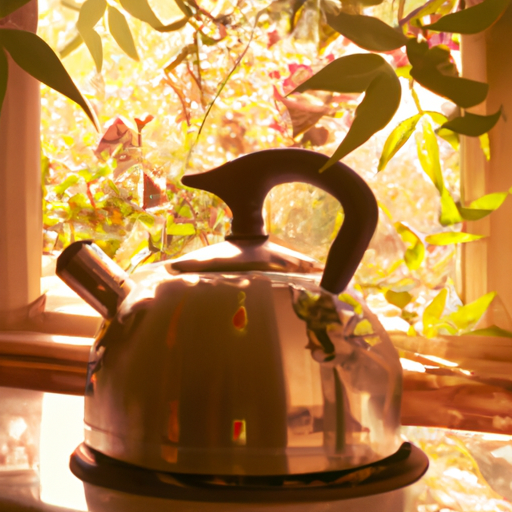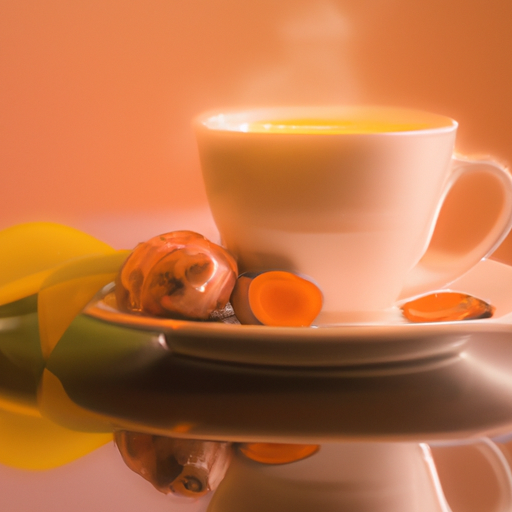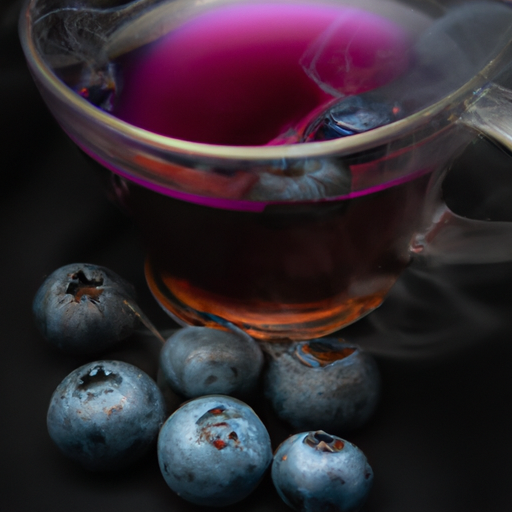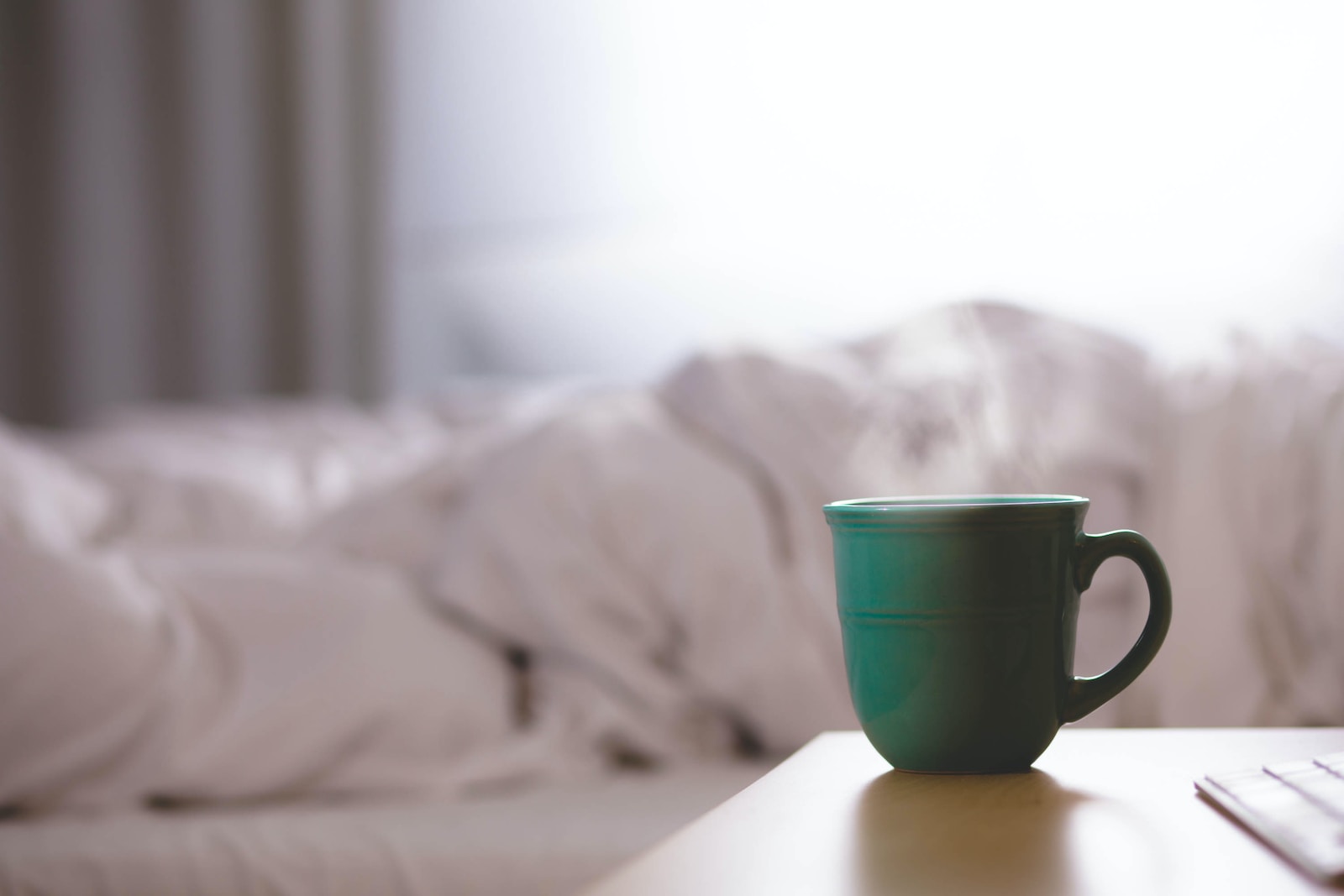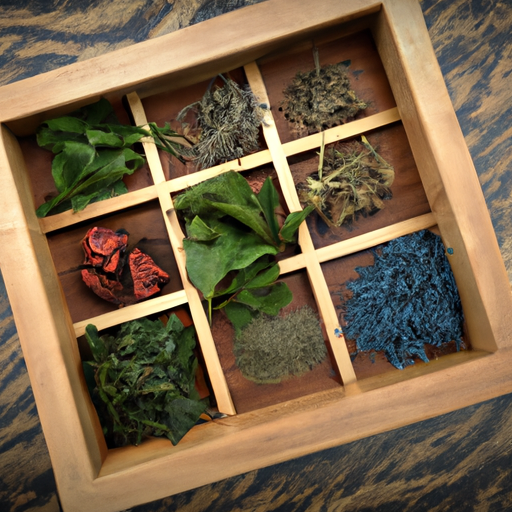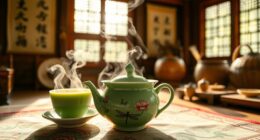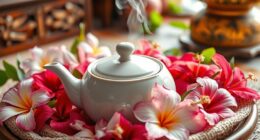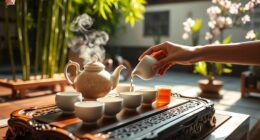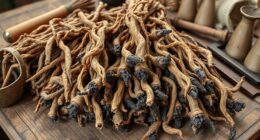Are you aware that the temperature at which you steep your herbal tea can have a major impact on its flavor and aroma? Even a slight change in temperature can drastically change the taste of your brew.
As an avid tea enthusiast, I have discovered that understanding the importance of temperature is crucial in achieving the perfect cup of herbal tea. In this article, I will delve into the world of herbal tea steeping temperatures, providing you with guidelines for different types of herbal tea, discussing the impact of temperature on flavor and aroma, and offering tools and techniques to help you achieve the ideal steeping temperature.
Additionally, I will highlight common mistakes to avoid and encourage you to experiment with temperature to discover your own personal favorite cup of herbal tea.
Get ready to elevate your tea experience by mastering the art of steeping at the perfect temperature.
Key Takeaways
- Different types of herbal teas require different steeping temperatures to bring out their desired flavors and aromas.
- Steeping herbal tea at the right temperature helps extract beneficial compounds like antioxidants, vitamins, and minerals.
- Using boiling water for delicate teas or water that is too cool for stronger teas can result in undesirable flavors and aromas.
- Experimenting with temperature and steeping times allows for a personalized tea experience and helps discover the perfect cup of herbal tea.
Understanding the Importance of Temperature in Herbal Tea Steeping
Let’s explore why getting the temperature right is crucial when steeping herbal tea! The importance of temperature control can’t be overstated when it comes to extracting the full health benefits from your herbal tea.
Different compounds in herbs are released at different temperatures, and steeping at the wrong temperature can result in a weak or bitter brew.
When steeping herbal tea, the temperature directly affects the extraction of beneficial compounds such as antioxidants, vitamins, and minerals. If the water’s too hot, it can cause the tea to become bitter and astringent, diminishing its health benefits. On the other hand, if the water’s too cool, the tea may not steep properly and you may not fully enjoy its potential benefits.
For example, chamomile tea is best steeped at a temperature between 200°F (93°C) and 212°F (100°C) to fully extract its calming properties. On the other hand, green tea should be steeped at a lower temperature of around 160°F (71°C) to 180°F (82°C) to prevent it from becoming bitter and to retain its delicate flavor.
Understanding the impact of temperature on the health benefits of herbal tea is key to achieving the perfect brew.
Now, let’s move on to temperature guidelines for different types of herbal tea.
Temperature Guidelines for Different Types of Herbal Tea
When steeping herbal teas, it’s important to consider the optimal temperature for each type of tea in order to extract the best flavors and medicinal properties.
For chamomile tea, the ideal temperature is around 200°F. This allows for a gentle extraction of its floral and calming qualities.
On the other hand, peppermint tea benefits from a higher temperature of 212°F. This enhances its refreshing and digestive properties.
Hibiscus tea should be steeped at a temperature of 195°F. This unlocks its vibrant red color and tart flavor.
Ginger tea requires a lower temperature of 180°F. This releases its warming and soothing characteristics.
Lastly, rooibos tea, a caffeine-free herbal tea from South Africa, should be steeped at 212°F. This brings out its sweet and nutty flavors.
Chamomile Tea
Relax and savor the soothing flavors of chamomile tea by steeping it at the recommended temperature. Chamomile tea is best steeped at a temperature of 200°F (93°C) for about 5-7 minutes. This allows the tea to release its delicate flavors and therapeutic properties.
To steep chamomile tea, simply bring water to a boil and then let it cool for a minute or two before pouring it over the tea leaves or tea bag. Steeping chamomile tea at the right temperature ensures that you get the full benefits of this herbal tea.
Chamomile tea has been known for its calming effects, making it a popular choice for relaxation and promoting sleep. It is also believed to have anti-inflammatory and antioxidant properties.
Now, let’s move on to the next section about peppermint tea.
Peppermint Tea
Indulge in the refreshing and invigorating flavors of peppermint tea, a delightful beverage that’ll awaken your senses and leave you feeling rejuvenated. Peppermint tea isn’t just delicious, but it also offers numerous health benefits. This herbal tea is known for its ability to soothe an upset stomach, relieve headaches, and improve digestion.
To brew a perfect cup of peppermint tea, start by boiling water and letting it cool for a minute or two. Then, pour the hot water over a teaspoon of dried peppermint leaves and let it steep for about 5-7 minutes. The longer you steep, the stronger the flavor’ll be. Once ready, strain the tea and enjoy its refreshing taste.
Now, let’s move on to the next delightful herbal tea, hibiscus tea, which brings its own unique benefits.
Hibiscus Tea
Savor the tangy and vibrant flavors of hibiscus tea, a tantalizing beverage that offers a myriad of health benefits and leaves you feeling revitalized. Understanding the health benefits of hibiscus tea is essential for tea enthusiasts. This vibrant and ruby-colored drink is packed with antioxidants that help lower blood pressure and cholesterol levels. It also aids in weight management and promotes a healthy immune system. Exploring different recipes using hibiscus tea can add variety to your tea collection. Try mixing it with fresh fruits for a delightful iced tea or infusing it with spices for a warm and comforting beverage. The possibilities are endless! As we move on to the next section about ginger tea, prepare to discover another invigorating and flavorful brew.
Ginger Tea
Get ready to invigorate your taste buds with a piping hot cup of ginger tea, and feel the warmth spread through your body. Ginger tea is not only delicious but also packed with numerous health benefits.
This aromatic beverage has been used for centuries to aid digestion, relieve nausea, and reduce inflammation. It’s known to boost the immune system, improve blood circulation, and even help with weight loss.
To make a simple ginger tea, just steep a few slices of fresh ginger in hot water for about 10 minutes, and add honey or lemon for extra flavor. For a more adventurous twist, try adding cinnamon or turmeric to your ginger tea.
Now, let’s move on to the next exciting tea on our list, rooibos tea, which is known for its rich flavor and antioxidant properties.
Rooibos Tea
Now that we’ve explored the invigorating properties of ginger tea, let’s delve into the world of rooibos tea.
Rooibos tea, also known as red bush tea, is a caffeine-free herbal infusion made from the leaves of the Aspalathus linearis plant native to South Africa. This delightful tea is not only bursting with flavor, but it also offers numerous health benefits.
Rooibos tea is rich in antioxidants, which can help boost the immune system and promote overall well-being. Additionally, it is known for its anti-inflammatory and anti-allergic properties.
To ensure the freshness and quality of your rooibos tea, it is important to store it in an airtight container away from heat and sunlight. This will help preserve its delicate flavors and beneficial compounds.
Now, let’s transition to the next section and discover the calming qualities of lavender tea.
Lavender Tea
Indulge in the soothing embrace of lavender tea, allowing its gentle aroma to transport you to a peaceful oasis, where stress and tension melt away like petals floating on a calm, lavender-scented breeze. Lavender tea, derived from the fragrant purple flowers of the lavender plant, offers a myriad of benefits. It is known for its calming properties, promoting relaxation and aiding in sleep. Additionally, lavender tea can help alleviate headaches and soothe digestive issues. To make lavender tea, simply steep one teaspoon of dried lavender flowers in hot water for about 5-10 minutes. Strain the tea and enjoy its delightful floral flavor. Sipping on a warm cup of lavender tea not only provides a moment of tranquility, but it also offers a range of health advantages. Transitioning to the impact of steeping temperature on flavor and aroma, it is important to understand how different temperatures can enhance or diminish the taste and scent of herbal teas.
The Impact of Steeping Temperature on Flavor and Aroma
Experience the delightful transformation of flavors and aromas when you steep your herbal tea at the perfect temperature. The impact of steeping temperature on the flavor and aroma of herbal tea is significant, as it can greatly enhance or diminish the overall experience. Not only does the temperature affect the taste, but it also plays a role in extracting the health benefits from the tea.
Different compounds in herbs are released at different temperatures, so finding the optimal temperature is crucial for maximizing the tea’s medicinal properties.
To control the steeping temperature, there are a few best ways to ensure a perfect cup of herbal tea every time. One method is to use a thermometer to monitor the water temperature as it heats up. This allows for precise control and avoids any guesswork.
Another option is to use an electric kettle with temperature control settings, which makes it easier to achieve the desired temperature without the need for a separate thermometer.
In addition to these tools, there are also techniques that can help achieve the perfect steeping temperature. For example, pouring boiling water over the tea and letting it cool for a few minutes can bring the temperature down to the ideal range. Alternatively, using a heat-resistant vessel, such as a glass teapot, can help retain heat and maintain the desired temperature throughout the steeping process.
Transitioning into the subsequent section about tools and techniques for achieving the perfect steeping temperature, it’s important to explore the various options available to tea enthusiasts.
Tools and Techniques for Achieving the Perfect Steeping Temperature
When it comes to achieving the perfect steeping temperature for herbal tea, I’ve found that using a thermometer is an invaluable tool. By measuring the water temperature precisely, I can ensure that I’m steeping my tea at the optimal temperature for unlocking its full flavor and aroma.
Additionally, I’ve learned that boiling water and cooling time play a crucial role in achieving the desired temperature. I find that allowing the water to cool for a few minutes after boiling helps me reach the ideal temperature for steeping herbal tea.
Lastly, electric kettles with temperature control have become a game-changer in my tea brewing routine. They allow me to easily set and maintain the desired temperature, ensuring consistent and perfect steeping every time.
Using a Thermometer
Using a thermometer is a nifty way to make sure you don’t steep your herbal tea at a temperature that could rival the surface of the sun. Thermometer accuracy is key when it comes to getting the perfect cup of tea.
There are alternative methods to using a thermometer, such as using a kettle with temperature control or relying on visual cues like steam or bubbles. However, a thermometer provides precise and reliable readings, ensuring that you steep your tea at the optimal temperature for flavor extraction.
Speaking of temperature, the next step is to consider boiling water and cooling time. This is crucial because different types of herbal teas require different temperatures. By paying attention to these details, you can achieve a perfectly steeped cup of herbal tea every time.
Boiling Water and Cooling Time
To achieve the perfect cup of tea, it’s important to pay attention to how long to boil the water and how much time to let it cool. Here are three important things to consider when it comes to boiling water and cooling time for steeping herbal tea:
-
Boiling water safety: Make sure to use a kettle or pot that’s safe for boiling water. Avoid using plastic containers, as they can release harmful chemicals when exposed to high temperatures. Instead, opt for stainless steel or glass.
-
Optimal cooling methods: After boiling the water, let it cool for a few minutes before pouring it over your herbal tea. This allows the water to reach the optimal temperature for steeping, which’s typically between 190°F and 205°F. To speed up the cooling process, you can transfer the hot water to a separate container or use a cooling method like placing the kettle in a bowl of ice water.
Now, let’s explore another method for achieving the perfect cup of tea: electric kettles with temperature control.
Electric Kettles with Temperature Control
With electric kettles that offer precise control over water heat, tea enthusiasts can effortlessly unlock the full spectrum of flavors and create a truly transcendent tea experience.
Compared to stovetop kettles, electric kettles with temperature control provide several benefits. First, they allow you to set the exact temperature needed for steeping herbal tea, ensuring optimal flavor extraction without any guesswork. This is particularly important because different herbs require different temperatures to release their unique flavors and health benefits.
Additionally, electric kettles heat water faster than stovetop kettles, saving you time and energy. The ability to maintain a consistent temperature throughout the steeping process also contributes to a more consistent and satisfying cup of tea.
Considering these advantages, electric kettles with temperature control are a game-changer for tea lovers.
Moving on to the next section about factors to consider when adjusting steeping temperature…
Factors to Consider When Adjusting Steeping Temperature
One important factor to consider when adjusting the steeping temperature of herbal tea is how it affects the extraction of flavors and aromas. The temperature at which you steep your tea can greatly impact the taste and overall experience. Different herbal teas have different optimal steeping temperatures, and finding the right temperature can enhance the flavors and aromas in your cup.
One of the factors to consider when adjusting steeping temperature is the type of herbal tea you’re brewing. Delicate herbal teas, such as chamomile or lavender, are best steeped at lower temperatures, around 175°F (80°C), to preserve their delicate flavors. On the other hand, robust herbal teas like peppermint or ginger can withstand higher temperatures, around 200°F (93°C), to extract their full-bodied flavors.
Another factor to consider is the desired strength of your tea. Steeping herbal tea at higher temperatures for a longer time can result in a stronger brew, while lower temperatures and shorter steeping times can produce a milder flavor.
By understanding these factors and adjusting the steeping temperature accordingly, you can achieve a perfect cup of herbal tea that’s rich in flavors and aromas. However, it’s important to note that there are also common mistakes to avoid when steeping herbal tea, which we’ll explore in the next section.
Common Mistakes to Avoid When Steeping Herbal Tea
When steeping herbal tea, it’s important to avoid some common mistakes that can affect the taste and quality of your brew. One common mistake is using boiling water for delicate herbal teas, which can result in a bitter or burnt taste.
Another mistake to avoid is not allowing sufficient steeping time, as this can lead to a weak and flavorless cup of tea.
Lastly, using water that’s too cool for stronger herbal teas can result in a lack of depth and intensity in the flavor.
By being mindful of these mistakes, you can ensure a perfectly steeped cup of herbal tea every time.
Using Boiling Water for Delicate Herbal Teas
To get the perfect cup of delicate herbal tea, make sure you don’t put the kettle on the back burner and let it boil away. Using hot water for delicate herbal teas can have a significant impact on the flavor and aroma of the brew. Here are three key reasons why you should avoid using boiling water for delicate herbal teas:
-
Preservation of delicate compounds: Delicate herbs contain volatile oils and compounds that can be easily damaged by high temperatures. Using boiling water can cause these compounds to evaporate, resulting in a loss of flavor and aroma.
-
Avoiding bitterness: Steeping delicate herbal teas in boiling water for too long can lead to a bitter taste. The longer the steeping time, the more tannins are released, resulting in a bitter and unpleasant brew.
-
Retaining subtleties: Delicate herbal teas often have subtle flavors and nuances that can be easily overpowered by boiling water. Using water at a lower temperature allows these delicate flavors to shine through.
By using water at the appropriate temperature, you can ensure a more enjoyable and flavorful cup of delicate herbal tea. However, not allowing sufficient steeping time can also impact the final result.
Not Allowing Sufficient Steeping Time
Don’t rush the process or you’ll miss out on the full flavor and richness of your delicate brew. When it comes to steeping herbal teas, achieving optimal flavor requires both the right steeping time and temperature.
Just like with any tea, different herbs have different ideal steeping times and temperatures. For delicate herbal teas, it’s important not to rush the steeping process. Steeping for too short a time or at too high a temperature can result in a weaker, less flavorful tea.
To bring out the best flavor, follow the recommended steeping time and temperature for your specific herbal tea. This will ensure that you get the most out of your brew and enjoy its unique taste.
Moving on to the next section, let’s discuss the issue of using water that is too cool for stronger herbal teas.
Using Water that is Too Cool for Stronger Herbal Teas
Using lukewarm water for stronger herbal teas is like trying to light a fire with damp wood – the flavors won’t ignite and the taste will fall flat.
To ensure a robust and flavorful cup of herbal tea, it’s crucial to use water that’s hot enough. Here are five important factors to consider:
- Water temperature affects the extraction of flavors from the herbs.
- Using cold water can result in weak and underwhelming tea.
- Steeping time should be adjusted for weaker herbal teas to compensate for the lower water temperature.
- The ideal water temperature for stronger herbal teas is around 195 to 205 degrees Fahrenheit.
- Experimenting with temperature allows you to discover your perfect cup of herbal tea.
By understanding the impact of water temperature and adjusting it accordingly, you can unlock the full potential of your herbal teas and create a truly satisfying and enjoyable tea-drinking experience.
Experimenting with Temperature to Discover Your Perfect Cup of Herbal Tea
By adjusting the temperature, you can unlock the full flavors and aromas of your herbal tea, creating a truly blissful and personalized tea experience. Experimenting with steeping times and alternative methods of temperature control can help you discover your perfect cup of herbal tea.
When it comes to steeping herbal tea, temperature plays a crucial role in extracting the optimal flavors from the herbs. While some herbs can handle higher temperatures, others are more delicate and require lower temperatures to avoid bitterness. This is where experimenting with temperature becomes essential.
One method to control the temperature is by using a thermometer. Different herbal teas have different temperature requirements, so it’s important to find the sweet spot for each type. Start by heating the water to the recommended temperature range for the particular herbal tea you’re brewing. Then, adjust the steeping time to find the perfect balance of flavors.
Another alternative method is to use water that has cooled slightly after boiling. This allows for a gentler infusion, which can result in a smoother and less bitter cup of tea. By slightly lowering the temperature, you can avoid overpowering the delicate flavors of certain herbs.
Remember, the key to finding your perfect cup of herbal tea is through experimentation. Take notes on different temperature and steeping time combinations, and trust your taste buds to guide you towards the most enjoyable and personalized tea experience.
Frequently Asked Questions
Can I use the same temperature to steep all types of herbal tea?
No, different types of herbal tea require different steeping temperatures. The temperature affects the flavors and properties of the tea. Experimenting with alternative steeping methods can enhance or alter the taste and experience.
How long does it take for the water to reach the desired steeping temperature?
To determine the optimal steeping time for different herbal teas, factors like tea type, leaf size, and desired strength should be considered. The time it takes for water to reach the desired steeping temperature depends on variables such as kettle type and starting water temperature.
Is there a specific temperature range that is considered optimal for all herbal teas?
Different steeping temperatures can have varying impacts on the flavor and aroma of herbal teas. It is important to consider the specific tea you are brewing, as each one may have its own optimal temperature range for the best taste and aroma.
Can I still enjoy the benefits of herbal tea if I don’t steep it at the recommended temperature?
Yes, the temperature of the steeping water does affect the taste and flavor of herbal tea. There are alternative methods for achieving the perfect steeping temperature without recommended tools, ensuring you can still enjoy the benefits of herbal tea.
Are there any alternative methods to achieve the perfect steeping temperature if I don’t have the recommended tools?
There are alternative methods to achieve the perfect steeping temperature for herbal tea, even without the recommended tools. Some options include using a meat thermometer or heating water to boiling and then letting it cool for a few minutes.
Conclusion
In conclusion, finding the ideal temperature to steep herbal tea is crucial for unlocking its full potential. By following the temperature guidelines for different types of herbal tea and using the right tools and techniques, you can enhance the flavors and aromas in your cup.
Avoiding common mistakes and experimenting with temperature allows you to create a personalized tea experience. So, step up your steeping game and savor the satisfying sensations of a perfectly brewed, temperature-tailored herbal tea.

